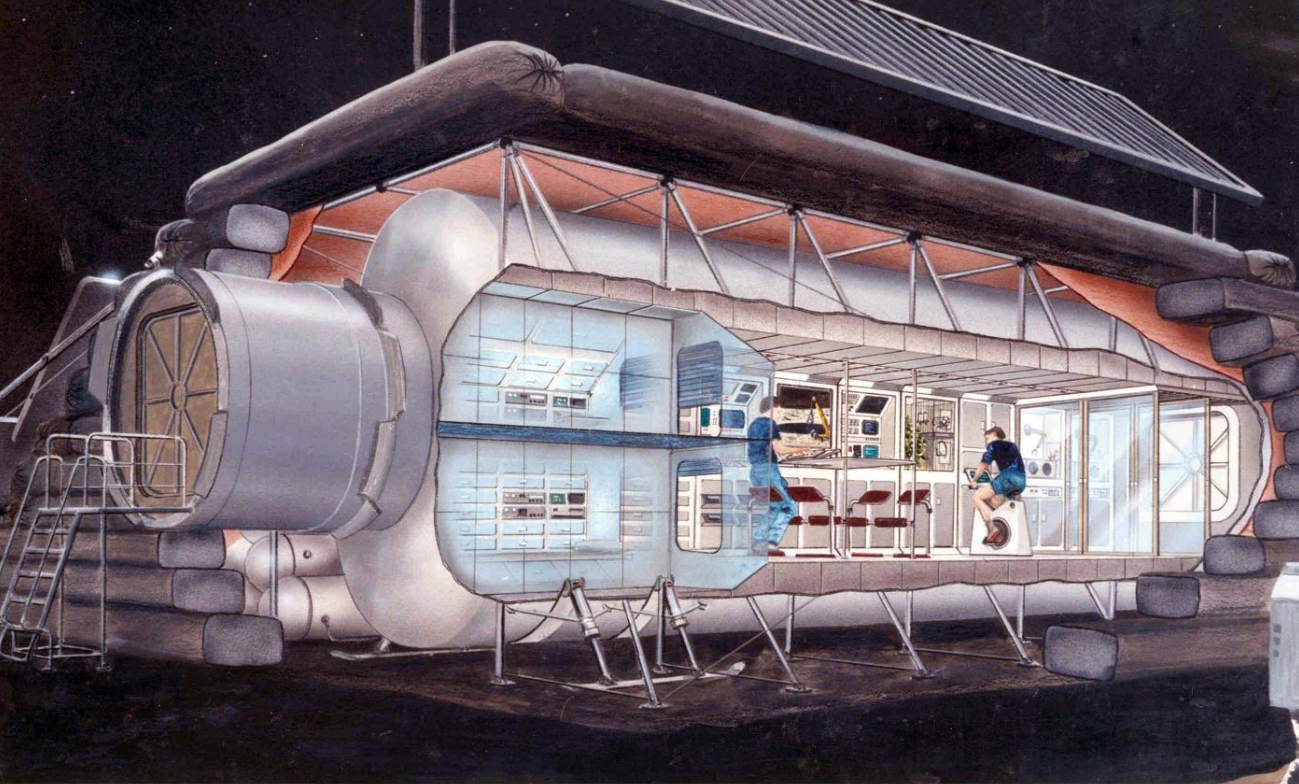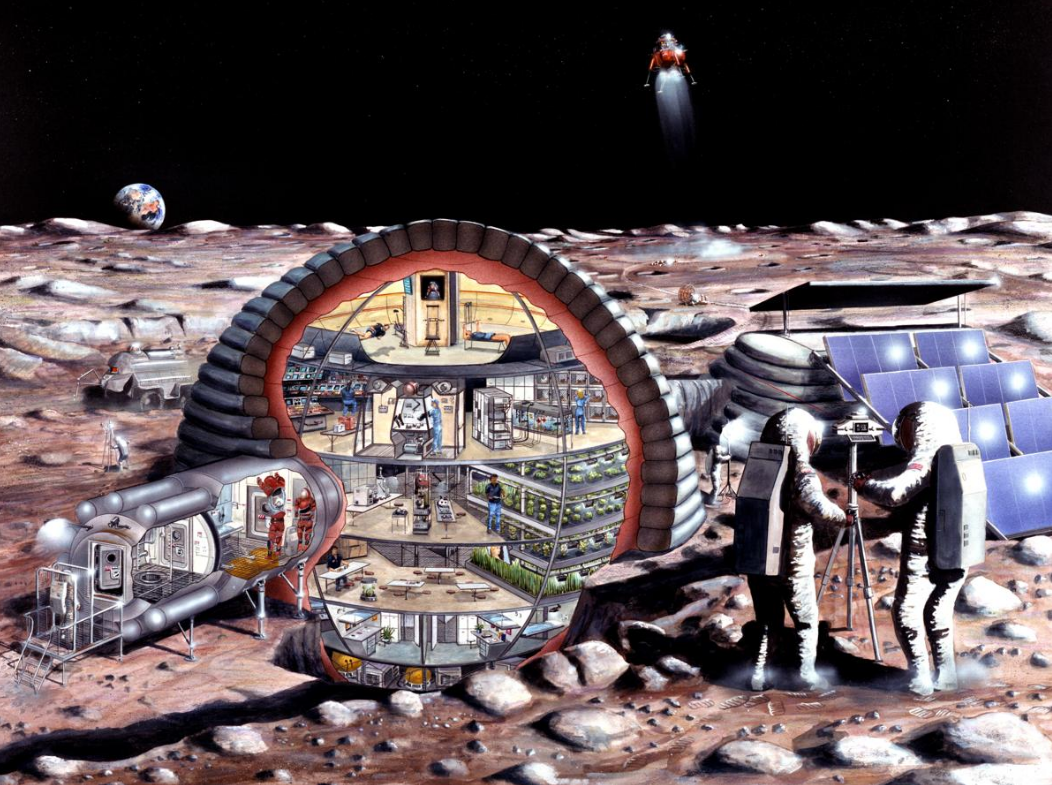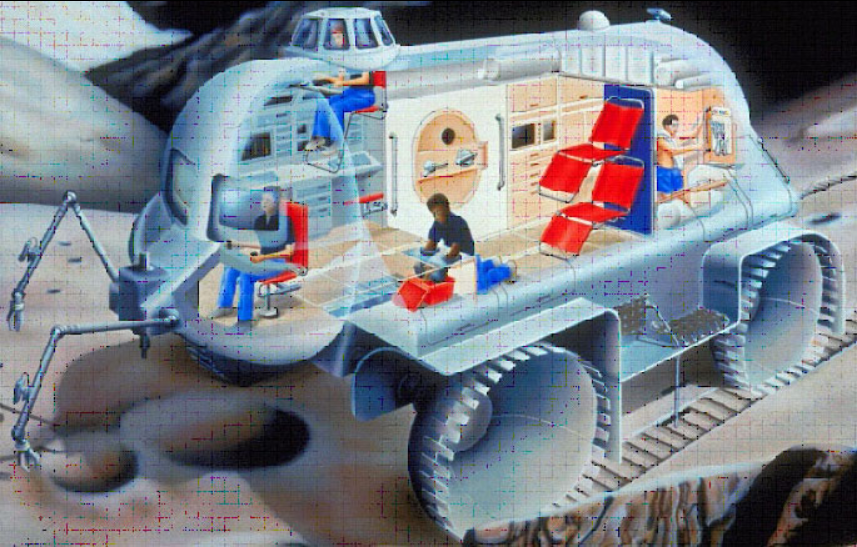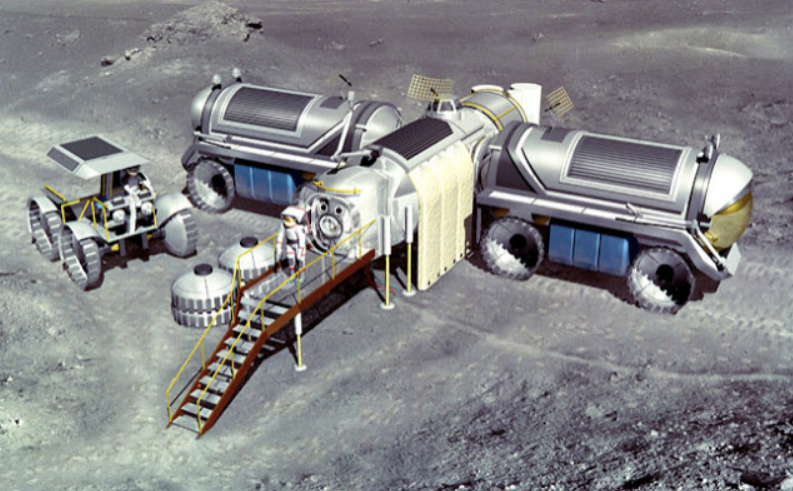A lunar outpost is a concept of a permanent or semi-permanent presence of humans on the Moon, a moonbase, by the United States space administration NASA. NASA requested an increase in the 2020 budget of $1.6 billion, in order to make another crewed mission to the Moon by 2025 (originally 2024), followed by a sustained presence on the Moon by 2028.
- moonbase
- semi-permanent
- moon
1. History
The concept of establishing a long-term human presence on the Moon can be traced back to the late 1950s. The Lunex Project, conceptualized in 1958, was a US Air Force plan to construct an underground Air Force Base on the Moon. On 8 June 1959, the US Army's Ballistic Missile Agency (ABMA) organized a task force called Project Horizon to assess the feasibility of constructing a military base on the Moon.
Project Horizon proposed using a series of Saturn[1] launches to pre-construct an outpost while in Earth orbit, with the intention of subsequently delivering and landing the completed assembly on the Moon. Additional Saturn launches each month would then ship supplies to the inhabitants.[1]



A lunar outpost was an element of the George W. Bush era Vision for Space Exploration, which has been replaced with President Barack Obama's space policy.[2] The outpost would have been an inhabited facility on the surface of the Moon. At the time it was proposed, NASA was to construct the outpost over the five years between 2019 and 2024. The United States Congress directed that the U.S. portion, "shall be designated the Neil A. Armstrong Lunar Outpost".[3]
On 4 December 2006, NASA announced the conclusion of its Global Exploration Strategy and Lunar Architecture Study.[4] The Lunar Architecture Study's purpose was to "define a series of lunar missions constituting NASA's Lunar campaign to fulfill the Lunar Exploration elements" of the Vision for Space Exploration.[2] What resulted was a basic plan for a lunar outpost near one of the poles of the Moon, which would permanently house astronauts in six-month shifts. These studies were made before the discovery of water ice (5.6 ± 2.9% by mass) in a polar crater,[5] which may substantially affect plans.

1.1. 1994 International Lunar Resources Exploration Concept
The International Lunar Resources Exploration Concept (ILREC) was a proposed mission architecture under President George H. W. Bush's Space Exploration Initiative (SEI) by Kent Joosten, an engineer at Johnson Space Center. The plan would have used the help of international partners, mainly Soviet Union, to assemble a lunar base and sustainable lunar transportation service. The program was not able to get off the ground as it was proposed at the end of SEI's very short lifespan with the only surviving project being Space Station Freedom (now the International Space Station)
1.2. 2005 Exploration Systems Architecture Study
The Exploration Systems Architecture Study (ESAS) is the official title of a large-scale, system-level study released by NASA in November 2005 in response to American president George W. Bush's announcement on 14 January 2004 of his goal of returning astronauts to the Moon and eventually Mars— known as the Vision for Space Exploration (and unofficially as "Moon, Mars and Beyond" in some aerospace circles, though the specifics of a human "beyond" program remain vague).
1.3. 2006 Reference Architecture
A reference architecture was established for this outpost, based on a location on the rim of the Shackleton crater, located in the immense South Pole-Aitken basin, near the Moon's south pole. At a presentation, on 4 December 2006, Doug Cooke, Deputy Associate Administrator, NASA Exploration Systems Mission Directorate, described an area "that is ... sunlit ... 75 to 80 percent of the time, and it is adjacent to a permanently dark region in which there is potentially volatiles that we can extract and use. ... This sunlit area is about the size of the Washington Mall."[6] (approximately 1.25 km²). The Indian Chandrayaan-1 orbiter (2008–2009) helped in the determination of the precise location of the outpost.[7]
Other locations considered for possible lunar outposts included the rim of Peary crater near the lunar north pole and the Malapert Mountain region on the rim of Malapert crater.
The outpost design included:
- Habitation modules
- Solar power units
- Unpressurized rovers
- In-Situ Resource Utilization (ISRU) unit
- Surface mobility carrier
The outpost would have been supplied by a mixed crew and cargo Altair lander, capable of bringing four astronauts and a payload of six tons to the Moon's surface.
As planned, an incremental buildup would begin with four-person crews making several seven-day visits to the moon until their power supplies, rovers and living quarters were operational. The first mission would begin by 2020. This would be followed by 180-day missions to prepare for journeys to Mars.
1.4. 2008 Concepts Study
On 6 June 2008, NASA announced a set of six research opportunities and requested proposals for research funding in response to the announcement.[8] The overall budget for research conducted as part of this "Lunar Surface Systems Concepts Study" was believed to be $2 million. Proposals were selected and contracts awarded in August 2008 by the NASA Constellation Lunar Surface Systems Project Office (LSSPO).
1.5. 2010/2011 Surface System Concept Review
The LSSPO was established at the Johnson Space Center in August 2007.[9] The LSSPO was studying lunar surface systems such as "habitation systems", ISRU, rovers, power production and storage, systems to meet science and exploration objectives and safety systems. The LSSPO was expected to conduct a surface system concept review in the 2010 or 2011 timeframe.
1.6. 2017/Present: Artemis Program
The Artemis program is a planned crewed spaceflight program carried out predominately by NASA, U.S. commercial spaceflight companies, and international partners such as the European Space Agency (ESA), JAXA, and the Canadian Space Agency (CSA) with the goal of landing "the first woman and the next man" on the Moon, specifically at the lunar south pole region by 2024. NASA sees Artemis as the next step towards the long-term goal of establishing a sustainable presence on the Moon, laying the foundation for private companies to build a lunar economy, and eventually sending humans to Mars. One primary target is Shackleton crater. In 2028 NASA plans on launching the Lunar Surface Asset, a small habitat to the surface of the Moon on either an SLS Block 1B or through an Artemis Support Mission on a commercial launcher. This would be the first crewed lunar base.
2. Justification
In the words of former NASA Administrator, Michael D. Griffin,[10]
The goal isn't just scientific exploration. ... It's also about extending the range of human habitat out from Earth into the solar system as we go forward in time. ... In the long run a single-planet species will not survive. ... If we humans want to survive for hundreds of thousands or millions of years, we must ultimately populate other planets. Now, today the technology is such that this is barely conceivable. We're in the infancy of it. ... I'm talking about that one day, I don't know when that day is, but there will be more human beings who live off the Earth than on it. We may well have people living on the moon. We may have people living on the moons of Jupiter and other planets. We may have people making habitats on asteroids ... I know that humans will colonize the solar system and one day go beyond.
3. Lunar Gateway
A station in lunar orbit can serve as a communications hub, temporary habitation module, and holding area for rovers and other robots intended for an outpost on lunar ground.[11] NASA leads a proposal for such a station, titled Lunar Gateway. The omnibus spending bill passed by Congress in March 2018 provided NASA with $504 million for preliminary studies during the 2019 fiscal year.[12] The final funding amount enacted by Congress was slightly lower at $450 million.[13]
4. Criticism
Criticisms come from groups that want the human exploration money diverted to Mars, from those who prefer uncrewed exploration, and from those who simply want the money spent elsewhere. The criticisms listed here mostly predate the discovery of significant amounts of polar water ice. Jeff Foust, writing for The Space Review, called the six themes that NASA released too "broad" and the explanations supporting them "shallow." He also argues that a Moonbase is a poor use of resources, since "science can be done for far less money by robotic missions—which also don't put human lives at risk."[14] The Los Angeles Times seconded that in an editorial, saying "Manned moon flight may appeal to baby boomers, but it makes little scientific sense for most space missions these days. Robots can now perform or be developed to perform, most of the tasks people would do at a moon station."[15]
Columnist Gregg Easterbrook, who has reported on the space program for decades, has criticized the plans as a poor use of resources. He writes that
Although, of course, the base could yield a great discovery, its scientific value is likely to be small while its price is extremely high. Worse, moon-base nonsense may for decades divert NASA resources from the agency's legitimate missions, draining funding from real needs in order to construct human history's silliest white elephant.[16]
According to Easterbrook, the billions of dollars that a lunar colony might cost should instead be devoted to exploring the Solar System with space probes; space observatories; and protecting the Earth from near-Earth asteroids.
Buzz Aldrin, the second of twelve men to have walked on the Moon, disagrees with NASA's current goals and priorities, including their plans for a lunar outpost. While not necessarily opposed to sending people back to the Moon, Aldrin argues that NASA should concentrate on a human mission to Mars and leave further lunar exploration and the establishment of a base there to a consortium of other countries under U.S. leadership.[17] In a July 2009 editorial in the Washington Post, he said that NASA's Vision for Space Exploration "is not visionary; nor will it ultimately be successful in restoring American space leadership. Like its Apollo predecessor, this plan will prove to be a dead-end littered with broken spacecraft, broken dreams, and broken policies." He continued by saying that:
the lunar surface ... is a poor location for homesteading. The moon is a lifeless, barren world, its stark desolation matched by its hostility to all living things. And replaying the glory days of Apollo will not advance the cause of American space leadership or inspire the support and enthusiasm of the public and the next generation of space explorers.[18]
The content is sourced from: https://handwiki.org/wiki/Astronomy:Lunar_outpost_(NASA)
References
- Please refer to Saturn (rocket family).
- Dale, Shana (2006-12-04). "Exploration Strategy and Architecture". NASA. http://www.nasa.gov/pdf/163896main_LAT_GES_1204.pdf. Retrieved 2007-01-12.
- "NASA Authorization Act of 2008 - Section 404 - Lunar Outpost". Library of Congress. 2008-09-27. http://thomas.loc.gov/cgi-bin/query/z?c110:H.R.6063:.
- "NASA Unveils Global Exploration Strategy and Lunar Architecture". 2006-12-04. http://www.nasa.gov/home/hqnews/2006/dec/HQ_06361_ESMD_Lunar_Architecture.html. Retrieved 2007-01-12.
- Colaprete, A.; Schultz, P.; Heldmann, J.; Wooden, D.; Shirley, M.; Ennico, K.; Hermalyn, B.; Marshall, W et al. (22 October 2010). "Detection of Water in the LCROSS Ejecta Plume". Science 330 (6003): 463–468. doi:10.1126/science.1186986. PMID 20966242. Bibcode: 2010Sci...330..463C. https://dx.doi.org/10.1126%2Fscience.1186986
- Microsoft Word - lunar_architecture.DOC http://www.nasa.gov/pdf/164021main_lunar_architecture.pdf
- Moonbase: In the Dark On Lunar Ice | Space.com | 26 December 2006 http://www.space.com/aol/061226_lunar_ice.html
- "Exploration Systems Mission Directorate - Lunar Surface Systems Concepts Study". NASA. 2008-06-06. Archived from the original on 2008-09-17. https://web.archive.org/web/20080917120619/http://procurement.nasa.gov/cgi-bin/eps/sol.cgi?acqid=130133.
- "Lunar Surface Systems Concepts Study - Compilation of Briefings". NASA ESMD. http://www.nasa.gov/pdf/240373main_06-06-08-LSS%20BAA%20Compilation%20of%20briefings%20teammb.pdf.
- "NASA's Griffin: 'Humans Will Colonize the Solar System'". Washington Post: pp. B07. September 25, 2005. https://www.washingtonpost.com/wp-dyn/content/article/2005/09/23/AR2005092301691.html.
- Jackson, Shanessa (11 September 2018). "Competition Seeks University Concepts for Gateway and Deep Space Exploration Capabilities". NASA. https://www.nasa.gov/feature/competition-seeks-university-concepts-for-gateway-and-deep-space-exploration-capabilities. Retrieved 19 September 2018.
- Foust, Jeff (June 12, 2018). "Senate bill restores funding for NASA science and technology demonstration missions" (in en-US). Space News. https://spacenews.com/senate-bill-restores-funding-for-nasa-science-and-technology-demonstration-missions/. Retrieved September 16, 2018.
- Dreier, Casey (February 15, 2019). "NASA just got its best budget in a decade" (in en). http://www.planetary.org/blogs/casey-dreier/2019/0215-fy2019-nasa-gets-its-best-budget-in-decades.html.
- Foust, Jeff (December 11, 2006). "Moonbase Why". The Space Review. http://www.thespacereview.com/article/764/1.
- "Don't colonize the moon". Los Angeles Times. December 10, 2006. http://www.latimes.com/news/opinion/la-ed-moon10dec10,0,2327043.story?coll=la-opinion-leftrail.
- Gregg Easterbrook. "Moon Baseless: NASA can't explain why we need a lunar colony". Slate. Dec. 8, 2006. http://www.slate.com/id/2155164
- Buzz Aldrin and David Noland. "Buzz Aldrin to NASA: U.S. Space Policy Is on the Wrong Track ." Popular Mechanics August 2009. http://www.popularmechanics.com/science/air_space/4322647.html?page=1
- Buzz Aldrin. "Time to Boldly Go Once More. Washington Post. July 16, 2009. https://www.washingtonpost.com/wp-dyn/content/article/2009/07/15/AR2009071502940.html
